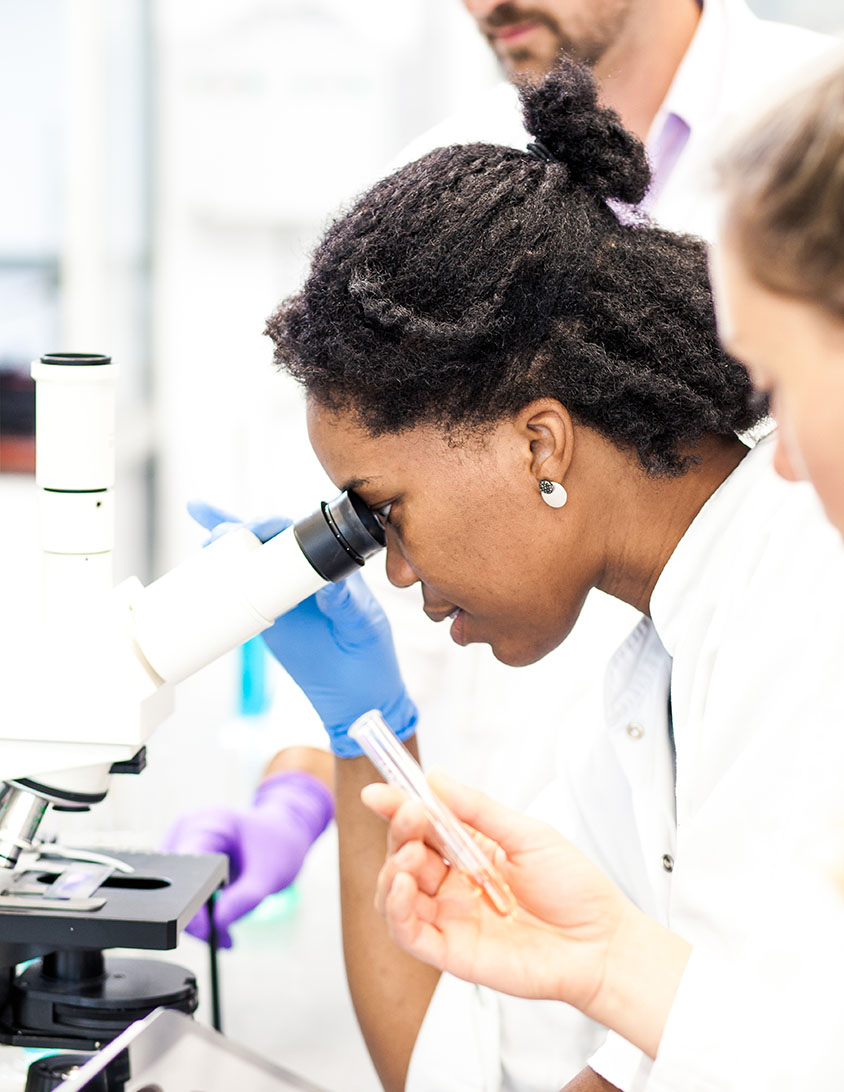Duchenne Muscular Dystrophy (DMD)
Diagnosis
Diagnosis
In diagnosing any form of muscular dystrophy, a doctor usually begins by taking a patient and family history and performing a physical examination. In addition to weakness, doctors may find unexpectedly large muscles that are not stronger, especially in the calf muscles (pseudohypertrophy), curvature of the spine (lumbar spine deviation), gait abnormalities when walking, and diminished muscle reflexes. History and exam may reveal delayed motor milestones, such as delayed walking (after 18 months), the “Gowers sign” (using one’s hands to push up from the floor), waddling or toe walking, or being unable to achieve certain tasks (hopping, jumping, stair climbing) that unaffected boys of the same age can do.
Much can be learned from these observations, including the pattern of weakness. A patient’s history and physical exam go a long way toward making a diagnosis, even before any complicated diagnostic tests are done.
Creatine kinase enzyme levels
Early in the diagnostic process, doctors often order a blood test called a CK level. CK stands for creatine kinase, and is a muscle enzyme that leaks out of muscle that is damaged. When elevated CK levels are found in a blood sample, it usually means muscle is being injured, though it is not specific to muscular dystrophy. For example, traumatic childbirth can cause elevated CK levels. A very high CK level suggests that the muscles (and not the nerves that control them) are the likely cause of the weakness, although it does not indicate exactly what type of muscle disorder might be occurring. High levels of CK may be found before the onset of symptoms, even in newborns affected by DMD.
In children with DMD, the CK level peaks (at 10 to 20 times the upper limit of normal) by age 2, then progressively falls at a rate of 25% per year. It eventually returns to a normal level when a considerable amount of muscle tissue has been replaced by fat and scar/fibrotic tissue.
Some liver enzymes, notably AST and ALT, can be elevated in muscular dystrophies. This is because liver enzymes also exist in muscle and are leaked into the blood during muscle injury; this does not reflect injury to the liver. All individuals with elevated liver enzymes should be considered for CK testing as well.
Genetic testing
Genetic testing involves analyzing the DNA of cells (usually blood cells) to see whether there is a mutation in the DMD gene, and if so, exactly where it occurs. Such DNA testing for DMD mutations is widely available in the United States.
Usually, genetic testing is indicated for patients with elevated serum CK levels and clinical findings of dystrophinopathy. Diagnosis is confirmed if a mutation in the DMD gene is identified. The genetic analysis is first directed to find large deletion/duplication mutations (70% to 80% of cases present with these kinds of mutations). If initial genetic analysis is negative, the analysis of small and micro deletion/duplication gene mutations is next, often called “next generation sequencing”. Commonly these days, next generation sequencing is the initial genetic test that is performed in many patients.
Female relatives of men and boys with DMD should undergo DNA testing to see if they are carriers of DMD. Women who are DMD carriers can pass on the disease to their sons and their carrier status to their daughters. In a minority of cases, girls and women who are DMD carriers may themselves show symptoms of DMD, such as muscle weakness and heart problems. These symptoms may not appear until adulthood (see Causes/Inheritance).
Several current therapies used to treat DMD (exon skipping drugs and gene therapy) require knowledge of a person's precise genetic mutation, so genetic testing has become important not only for diagnosis but also for mutation specific treatment.
The benefits of genetic testing include diagnosis confirmation, identifying specific mutations for targeted treatment, facilitating carrier testing in female relatives, and potentially avoiding unnecessary muscle biopsies.
Muscle biopsy
Muscle biopsy is now rarely indicated because of the wealth of knowledge that genetic testing provides. However, in ambiguous clinical circumstances, muscle biopsies can yield very valuable information. To obtain more information, a doctor may order a muscle biopsy, the surgical removal of a small sample of muscle from the patient. By examining this sample, doctors can tell a great deal about what is actually happening inside the muscles.
Modern techniques can use the biopsy to distinguish muscular dystrophies from inflammatory and other disorders and to distinguish among different forms of muscular dystrophy. For instance, the amount of functional dystrophin protein found in a muscle biopsy sample sheds light on whether the disease course is likely to be consistent with a more severe DMD phenotype, with no dystrophin present, or a milder Becker muscular dystrophy (BMD) course, with some partially functional dystrophin present.
Histologic (tissue-related) evidence of a cardiomyopathy may be observed from birth among male children with DMD. Although not typically performed, endomyocardial (inner cell layer of the heart) biopsy often shows a variable distribution of dystrophin in cardiomyocytes (heart muscle cells).
If the suspicion of DMD remains high despite negative genetic analysis, dystrophin detection by western blot technique or staining with selective antibodies is carried out in the tissue derived from a muscle biopsy. The western blot is useful to predict the severity of the disease as the quantity of dystrophin present in the analysis is related to the clinical presentation. Traditionally, DMD has less than 5% of the normal dystrophin quantity, intermediate disease has 5% to 20% of normal dystrophin, and BMD has more than 20% of normal dystrophin levels.
Cardiac monitoring
Almost all people with DMD who are older than 18 years of age develop a type of heart disease known as DMD-associated cardiomyopathy. Cardiomyopathy in patients with DMD may be associated with conduction abnormalities or changes to the shape and function of the heart. A doctor may observe characteristic changes in an electrocardiogram. Also, structural changes in the heart, such as inflammation and fibrotic scarring of the heart or valvular heart disease (especially affecting the mitral valve when it occurs), can be detected by cardiac MRI. Therefore, electrocardiogram and noninvasive imaging with echocardiography, or cardiac MRI, are essential, along with consultation with a cardiologist.
Pulmonary monitoring
Similarly, all people with DMD develop weakness of the muscles responsible for breathing and coughing, making regular respiratory monitoring essential. Pulmonary function tests can help assess respiratory muscle strength and are important for guiding supportive interventions and preventing breathing complications. Also, as individuals with DMD age, many develop sleep apnea, which can be detected through sleep studies, also known as polysomnography.
Additional reading
- Birnkrant DJ, et al.; DMD Care Considerations Working Group. Diagnosis and management of Duchenne muscular dystrophy, part 1: diagnosis, and neuromuscular, rehabilitation, endocrine, and gastrointestinal and nutritional management. Lancet Neurol. 2018 Mar;17(3):251-267. doi: 10.1016/S1474-4422(18)30024-3. Epub 2018 Feb 3. Erratum in: Lancet Neurol. 2018 Jun;17(6):495. doi: 10.1016/S1474-4422(18)30125-X. PMID: 29395989; PMCID: PMC5869704.
- Birnkrant DJ, et al.; DMD Care Considerations Working Group. Diagnosis and management of Duchenne muscular dystrophy, part 2: respiratory, cardiac, bone health, and orthopaedic management. Lancet Neurol. 2018 Apr;17(4):347-361. doi: 10.1016/S1474-4422(18)30025-5. Epub 2018 Feb 3. PMID: 29395990; PMCID: PMC5889091.
Last reviewed May 2025 by Stephen Chrzanowski M.D., Ph.D.

